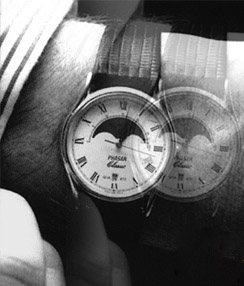Double vision
Double Vision, misaligned vision, or ghosting, is when your visual cortex perceives two images when there should be one.
This phenomenon usually occurs as an intermediate step in your vision improvement and is to be differentiated from Astigmatism ("Directional Blur"). Your vision biology is constantly adjusting to environmental stimulus, whereby different parts of your system respond at different rates. After clearing up Ciliary Spasm and after starting to improve the physical shape of your eyeball, your visual cortex already receives plenty of clear data. Our brains however were not built to handle artificial changes to the natural Focal Plane. This means that even when the image hitting your Retina is clear after reducing the strength of your glasses, your brain has to relearn how to create a single clear image out of this new data. This can take longer than resolving the refractive state of your eyeballs and manifests in multiple overlapping clear images of the same image. This might be somewhat common as you start improving your eyesight - more ghosted images will begin to appear as your visual cortex is constantly learning to readjust to new signals.
If there is too much double vision, you might have to step up to clear it and avoid blur adaptation.
Double Vision can be more pronounced once you are in the Low Myopia range, since every small change in your diopter strength then results in a larger shift of your Focal Plane.
For help resolving double vision see the Guide:Resolving double vision.
Transient Astigmatism
Transient astigmatism (article, video) is double vision and measurable cylinder that occurs when you reduce spherical and is temporary, so you should stop reducing and wait for it to disappear plus a little bit extra time, and reduce less aggressively next time. It becomes more severe when you reduce too quickly[1] or too much or too often.
Even though it's functionally the same as real astigmatism (although rapidly changing on axis and amount), do not get cylinder correction for it, to the maximum extent possible, since you're just transitioning between two spherical values. If you do, you would just put extra load on your visual cortex for no reason, slowing down your progress.
If it's too noticeable, you can step up spherical, but if it's not that bad ("if you don't notice it, or if you hardly ever notice it, or if it's really just something that the optometrist shows and you see a tiny little bit better"), it's also OK to leave it.
If you somehow created a very large amount of transient astigmatism, such as this person who had up to 4.25 D of myopic defocus, you might consider adding some cylinder correction, but only as a last resort.
What is the difference between astigmatism double vision and endmyopia double vision?
Astigmatism refers to a condition that creates directional blur, that when significant enough requires cylinder correction. This is what directional blur looks like.
Double vision, there are many kinds of it. For example, astigmatism might present itself as double vision but astigmatic blur doesn't have to have DV. But there can be double vision that's not caused by astigmatism.
There's no such thing as EM DV. But there is something Jake refers to called transient astigmatism. Which can come in various forms. Double vision, multiple transparent copies, ghosting, and other things of the sort.
When he talks about transient astigmatism he is referring to a transition period that exists while you are making gains. A period where your myopia has improved to the point where things are clear in terms of myopic blur, but you still have some disturbances in your vision.
There's really a lot of overlap honestly. Don't take the definitions too seriously. They're just ideas to help you look at what you're actually seeing. Because often people see things, but do not pay attention to how exactly these things look to them.
The goal is to get familiar with the nuances of blur. Because there are many different ways blur can look.
See also
- Blur (blur is different than double vision)[2][3]
- https://www.youtube.com/watch?v=7qdJaPUUNRM
References
- ↑ "So people that push the reductions get this transient astigmatism symptom that’s kind of a pain." https://endmyopia.org/ruis-glasses-and-headaches-9-75-to-6-00-progress/
- ↑ https://endmyopia.org/the-giant-double-vision-thread/
- ↑ https://endmyopia.org/reminder-tip-recognize-double-vision/
